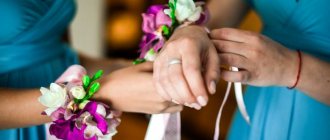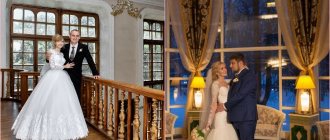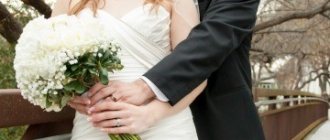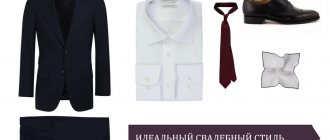People love weddings—the age-old tradition of publicly exchanging vows to love and cherish each other no matter what life may bring. Since a wedding is considered one of the best moments that can happen in life, couples go through a lot to create the perfect ceremony. Every photographer who photographs weddings must keep this in mind, as he has a serious responsibility. As a professional, you must help couples achieve their goals.
If you are faced with such a challenge, here are some tips for you on how to take wedding photos like a pro.
Organization and management
Meet with your clients so you can learn their wishes. They may have preferences about what and how they want to appear in a photo. Take notes during the conversation and create a checklist of all the nuances. Discuss all the nuances, coordinate the shooting locations so that guests can get there, especially if these are group photos. Show samples of your previous work.
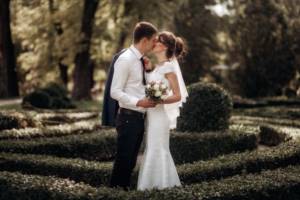
Victoria Bezhan
Preparing for shooting
- First of all, you need to work out a plan for the shooting day , which is discussed before shooting. There should be 2 routes for the walk : 1st for good weather, 2nd for bad weather. It's good to know a few backup spots close to the shooting route.
- A wedding photographer must keep track of time and understand how much time is needed for shooting and how much for travel, coordinating these points with the driver and the couple.
- Having agreed on the shooting locations, it will be useful to walk through them , look at angles, sketch out ideas for shooting and write it all down in a notebook.
- If the future newlyweds do not feel confident in front of the camera, you can (and even should) invite them to film a pre-wedding love-story , in which they will get used to you and your camera, which will allow them to be more relaxed at the wedding itself and, as a result, get more lively and emotional photos. By the way, photos from the love-story can be shown as a slide show at the wedding itself, which will undoubtedly add points to you and serve as additional advertising for your services.
- Discuss props with the couple . Props will help you relax and add personality to the shoot. Try to offer something truly original; many people have balloons, soap bubbles, and ridiculous signs; they are out of fashion. But a ferret or a wedding dachshund is closer to the point.
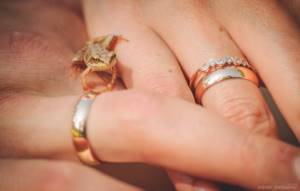
The main thing in working with a couple is the mood! For them, a wedding is a celebration, not a marathon to create 1,500 staged photographs. Therefore, the first thing you need to do is make sure that they are comfortable, neither cold nor hot, and that the bride’s feet do not bleed (we strongly recommend that you take comfortable, replaceable shoes for the shoot).
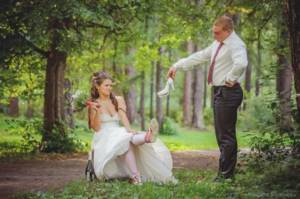
At the registry office you need to show all your professionalism and quickly, in low light conditions, take staged photographs before registration, not to miss the moments, views, emotions of the guests at the registration itself, and take a good group photo with the guests after. If this is your first time at the registry office, to help you, you can look for the works of more experienced colleagues from the desired registry office, and use them as a hint for positions and places, and of course, improvise.
The guys, of course, will need your support and advice on how best to stand up, so you need to know a certain number of poses for photographing (you can make yourself a cheat sheet on your phone). But the most vivid photographs are produced when people behave naturally. Here, each photographer has his own techniques and methods. I just ask the guys to do some action: take a walk, look into each other’s eyes and say the most tender words, etc.
Guests on a walk can either set the mood or ruin everything. It’s not a good idea to carry them along with you the entire walk; it’s better to first photograph everyone who wants to take pictures with the newlyweds, and then invite them to come up with a creative greeting, or come up with a quest for them, so that you and the couple have time to calmly take the pictures you’ve planned. But everything is individual and it is important to discuss these points at the meeting before the shoot.
The most important thing is mood and emotions , if this is not there, you need to make every effort to create it (here the photographer acts as a psychologist), if there is, then just have fun with everyone, and take pictures that will convey this mood.
Camera
High quality images are expected of a professional photographer, and you should expect the same from your gear. Choosing the right camera within your budget is a vital process, and if you'll be photographing your wedding alone, having a backup camera is highly recommended. Here's what's important for a good camera:
- Interchangeable lens
- Possibility of photographing in RAW format
- Fast and accurate autofocus
- Multiple memory card slots
- Excellent shooting in low light conditions
Where to start and how to develop a wedding portfolio?
At first, when you don’t yet have a wedding portfolio , orders for weddings can only come from close friends and relatives. If you want more orders and real earnings, then you need to be active. In photography, a good portfolio is at least half the success. After all, they greet you “by their clothes.” The second half is your communication skills and what result and impression you will leave.
At first, there is nowhere to get a portfolio, because there is no experience, and there is nowhere to get experience, because there is no portfolio and no orders. This is such a vicious circle.
You can break it by starting to photograph weddings as a second photographer or as an assistant to the main photographer. You may have to work for free at first, but this investment of time and effort will pay off handsomely later! After all , first you work on your portfolio, then it works for you. Accordingly, you need to ask to shoot with familiar photographers, or even better, with professionals whose photographs you like and serve as a guide. Why should they take you? A photographer at a wedding is like a Christmas tree hung with photographic equipment, often you need to bring something, serve something, hold a reflector. It's also a good idea to photograph guests while the main photographer is working with the couple.
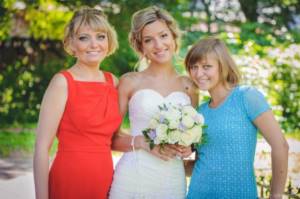
Accessories
The basic process of photography is controlling light. Flash and portable constant light give you enough light to get creative. This also ensures that the subject is sufficiently lit. Bring extra batteries for flashes and flashlights. And don't forget about camera batteries.
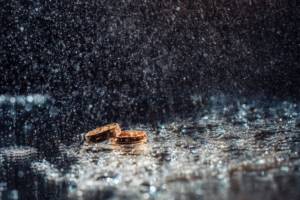
Victoria Bezhan
Straps will allow you to hold your camera securely, but you will need to make sure that they are securely attached to your camera as well as to you. Accidents happen and few people want to break a camera, especially during a wedding ceremony. For shooting from one angle and long exposures, you need to use a tripod.
Another key accessory to have is a pannier or backpack. This could be a small camera bag or a comfortable, roomy photo backpack.
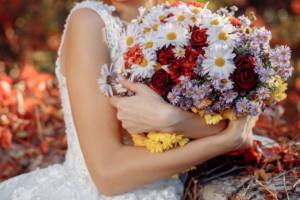
Victoria Bezhan
Don't forget to bring a laptop with photo editing software. Your clients may want to check the pictures immediately.
Equipment for a wedding photographer.
Why am I talking about equipment after skills? Yes, because good photographic equipment will help develop the skills of a photographer, but will not help at all if they are absent.
An important point is that beginning photographers are not always ready to invest large amounts of money in photographic equipment for photographing weddings, especially if they do not yet have such experience and are not sure whether they will seriously engage in wedding photography. In this case, photo rentals come to the rescue. Why are photo rentals a salvation for beginners? But because it is often simply impossible to get high-quality results in difficult lighting conditions with an entry-level SLR camera. And if we are talking about commercial wedding photography, then the rental cost is included in the cost of shooting and the novice photographer kills several birds with one stone: he provides high-quality photographs to the couple, which is the most important thing in this whole process, and receives high-quality photographs in his portfolio. It is also important to mention the impression that the photographer and prof. equipment and an entry-level DSLR, which every 4th person now has, will impress the guests. In the first case, it is likely that other orders will appear from those who saw such a photographer at work; in the second, it is very unlikely. But the most important thing, of course, is the result of the shooting.
Choosing a camera for a wedding photographer
To photograph a wedding, it is best to use a camera with a full-frame sensor from a brand you are already familiar with (the same as your current camera, if it is an entry-level one). Of course, using a full-frame camera or full frame is a recommendation, and this does not mean that a wedding cannot be photographed with a cropped lens. It’s just that a camera with a full-frame matrix has a number of advantages - higher operating ISOs, which will allow you to take high-quality pictures with a low noise level, high matrix resolution, which is useful for framing, and others. Read more about camera models for wedding photographers in the following. articles, I plan to write a detailed review of photographic equipment for photographing weddings. Subscribe to updates so you don't miss out.
Lenses for wedding photography
Lenses for wedding photography must meet the following criteria:
- Be sharp at all focal lengths
- Be fast, preferably with a constant aperture of 2.8 (for zoom lenses)
- Be universal. You may miss the most important point when changing lenses, so it is better to choose 2 high-quality lenses that will cover the most working focal lengths (for example, 24-70 f2.8 and 70-200 f2.8 ) and other lenses at your discretion. There will also be a separate article about lenses for wedding photography.
Other equipment
It is also good to have with you:
- A convenient photo bag or photo backpack that will fit all your equipment
- External flash
- Reflector for shooting in sunny weather.
- Spare batteries for flash and camera.
- Spare camera. A wedding is a moment that cannot be re-shot, and an indicator of good service is readiness for any surprises.
This is the basic set of photographic equipment for a wedding, everyone complements it in their own way.
Filming a story
You are responsible for capturing and preserving the memories from your wedding day. Be observant and capture different emotions to create a photo essay.
- Focus on smiles and laughter
- Look for tears. However, keep in mind that sometimes people who cry are not very attractive. Tears of joy are most often accompanied by a smile, but not always, keep this in mind
- Capture the beauty of the event: the people, the location and the design. Notice small details
- Capture reactions and interactions: father-daughter dance, firm handshake and greeting hug
- Different perspectives. Don't shoot from one angle. Hold the camera high above your head or crouch down. Shoot between objects to create natural frames. You may have to ask someone to move back for a good shot. Be bold, but not cocky.
- Take group photos and don't forget to take family photos
- Sort all the pictures after the event
- If possible, create and present a slideshow showing some of the pictures taken during the holiday
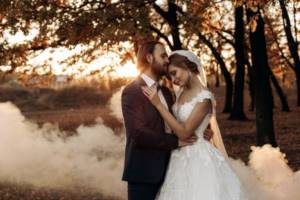
Let these tips serve you. Rest assured that preparation will help you weather unexpected disruptions. Above all, have fun!
Follow the news: Facebook , VKontakte and Telegram
comments powered by HyperComments
How to photograph a wedding - valuable tips for a beginner photographer
Artem Kashkanov, 2016
A wedding is an unforgettable event that happens once in a lifetime... But not for a photographer! For a photographer, a wedding is a job, and it’s an interesting and creative one, with a high price for mistakes. A wedding photographer must be one step ahead of events throughout the day, process a huge amount of information in his brain in a split second in order to take a photo from the right angle and at the right moment, be able to find a common language with the guests and not torment them with endless shooting of takes. After the shooting is completed, then you still need to process the footage for a long time and scrupulously - adjust levels and colors, suppress noise, etc. Are you sure you want to get involved in this? If yes, then this article is for you! 

This article is something like a “young fighter course” for a novice wedding photographer who has finally decided to try his hand at wedding photography. The first order happens unexpectedly - one of my friends calls and says: “Come and take a photo, there won’t be anything special, you just need a report, they’ll give you money. You’re a photographer!” The first feeling you experience is fear. What if I can’t handle it? What if something goes wrong? I'll tell you the story of my first wedding shoot...
This was in the early 2000s - then my brother, who at that time was a videographer, called me and said, “A friend of a friend of mine is getting married on such and such a date.



That's when I was afraid!

If you've never photographed a wedding...
Even if the customer says, “there will be no staged shooting, just a report is needed,” staged shooting will still take place.




A wide-angle lens is good for interior photography.
Don’t be lazy to go to the place where the wedding walk is planned in advance - it’s better to do this on the weekend when other weddings are taking place. Moreover, it is better to do this at the time of day when your event is planned. Take a closer look at the work of photographers - from what angles they photograph young people and what equipment they use - wide-angles, telephotos, flashes. When they're done and gone, walk through these places yourself and take photos of them - then, when you look at the photos on the computer, imagine how best to form a composition with the couple in the foreground. Pay attention to which side the light is coming from and how best to position people. Brush up on your portrait photography knowledge and skills. The article How to photograph a portrait will help you with this. If you are too lazy to read, then the general principles are as follows:
- Do not photograph a person point-blank with a wide-angle lens. Because of this, the proportions of the face are distorted and the person in the photo does not look like himself.
- A frontal angle is most often not the best solution. Try to photograph half-turn and three-quarters (an intermediate position between full-face and half-turn).
- Do not take pictures unless absolutely necessary against the light - there is a high risk of getting dark silhouettes on a white background. If there is no other way, use positive exposure compensation or flash so that the foreground is developed.
- The model's gaze does not necessarily have to look into the camera. If you're photographing a couple, try different combinations.
- The optimal focal length for a medium-ground portrait (waist-length) on a cropped lens is 50 mm, and on a full frame 85 mm. More is possible.
- The longer the focal length, the more the background is blurred.
- You don't always have to blur the background as hard as you can. When shooting a portrait against a landscape (which often happens while walking), it is better to do this with a closed aperture.
- Male portraits look better with “ringing” sharpness; they are best taken with a closed aperture. Women's portraits are softer and are best shot with an open aperture.
- Make bokeh (background blur pattern) your assistant - read more in the article Bokeh - the great power of artistic photography
Evaluate the capabilities of your equipment. The camera itself doesn’t solve much; the lens plays a big role. You can, of course, get by with one kit lens, but the photographs from it are purely “technical”, without mood or character. The simplest and cheapest thing you can add to your arsenal is a 50mm/1.8 lens. You don’t have to buy it in a store - you can borrow it from friends (if there are photographers among them), in the end you can buy used on Avito, then sell it at the same price - it’s a marketable product. Also, in almost every city there are services for renting photographic equipment, where you can rent a body or more serious optics - up to “top” professional bodies and lenses. You can easily include the rental price in the cost of your services by warning the client - “it will be only 3,000 more expensive, but the shooting will be done with modern professional equipment,” I’m sure no one will refuse such an offer.
A fast lens is, of course, good, but there is another thing without which a photographer has nothing to do at a wedding - an external flash. Many words have already been said regarding the merits of this device, for example, here - Using flash in photography. If you have a choice between buying a fast lens or an external flash, I recommend an external flash. Even with a dark kit lens, it allows you to take photographs of acceptable quality indoors with soft fill light.
Try to take photos in such a way that you don’t have to “Photoshop” them later. This is not about correcting levels, curves, white balance, cropping - this is something like “developing”. This refers to “blurring out” unnecessary objects in photographs - a tree sticking out of the head in the background, garbage cans, unnecessary interior elements, bags piled in the corner. This recommendation is especially relevant for small rooms, such as the bride’s room (not in the registry office, but at home) - sconces, paintings, and other things hanging on the walls really like to appear “stuck into the head” in photographs. Choose your angle carefully, at least for staged photography!
A blurry background in a portrait is good, but a background that is in harmony with the foreground is even better! Look for shooting positions so that the foreground and background complement each other. These can be elements of the interior, landscape, architecture. Remember how you take photographs and are photographed while traveling - against the backdrop of something and apply these skills to form a composition with young people. I can’t give a single recommendation - every interior and landscape is unique.
Another important accessory is the camera battery. If he is alone, then you will have a new headache - the battery is on the last bar, and the wedding does not think of ending yet. And so you start running from outlet to outlet and in the intervals between some key events you try to recharge the battery at least a little. All this can be solved by purchasing a second battery - while the main one is charging, you take pictures with the spare one. By the way, it is not necessary to buy an original battery. Chinese analogues practically do not differ in quality, but are several times cheaper. It will do as a backup. The same goes for batteries for an external flash - if you don’t have a spare set, buy at least 4 alkaline batteries in reserve.
The flash drive that was enough for you to photograph picnics and park walks also tends to run out at the most inopportune moment during wedding photography. Keep this in mind. Provide yourself with flash memory so that you can shoot at least 1,500 photos in RAW format. I strongly do not recommend photographing a wedding in Jpeg. Almost always the best photos are retouched and processed, and here the RAW format has many advantages over Jpeg. You can read about the main advantages here.
Assembling a photo backpack
If possible, you should put everything you have in it - a camera, all lenses, batteries, chargers, flash drives. For outdoor photography, a polarizing filter can be useful. We clean all our optics until they shine - for this we use special cleaning products and devices, such as Lenspen. It’s a good idea to do the same with the camera’s matrix. It’s also a good idea to take care if the lens suddenly gets dirty, it happens - I started to take the camera out of my bag and accidentally grabbed the lens, leaving a greasy fingerprint on it. In this case, you can use a simple protective filter and a pencil to clean the optics. If suddenly a problem occurs, we simply twist it and continue shooting. When we have time, we clean it with a pencil and screw it back on.
At a wedding, something can go wrong not only with the equipment, but also with the photographer himself.

"Ambushes" for the photographer
1. Winter photography . If the camera is attacked by snow, it is not particularly scary. The meanest thing that can happen and, as a rule, happens is the fogging of the optics after you return from a walk to a warm room. The walk is over, we arrived at the registry office, the most solemn moment comes and then... In the photographs everything looks like smoke! This is a very serious puncture. To avoid this, advanced wedding photographers use two cameras - one for shooting in the cold, the other for shooting in warm weather. In principle, you can get by by changing the lens - if you have already started shooting on the street with one lens, shoot with it until the end of the walk, do not open your backpack unless absolutely necessary and do not freeze all your optics!
2. Dark cafe . It happens that the interior of the cafe where the banquet is being held is made in dark colors, including the ceiling. In this case, the usual technique of shooting with flash “from the ceiling” loses its meaning. If you shoot head-on with flash at minimum ISO, you will get bright faces against a black background. To work on the background, you need to increase the ISO up to 1600 units; the flash also fires, but much weaker - this will reduce the glare on faces. Flash diffusers a la softbox also help with these.
3. Interiors with mirrors . Not only is the photographer himself reflected in these mirrors, but when shooting with flash, the photographs turn out to be very dark - try taking a photo of yourself in a mirror with a flash and see for yourself. If there are a lot of mirrors in the interior, you will have to choose the angle more carefully.
4. Interiors with colored walls and ceilings. If the ceiling is green, then the flash light reflected from it will color everything in green tones - it will look like a “Shrek wedding.”


The ceiling is black, the walls are red - a complete set for the “happiness” of the photographer 

5. The battery runs out . This has already been mentioned above, but let me remind you again. As soon as the battery shows signs that it is close to discharge, do not delay replacing it with a charged one, since it can run out at any moment. If during walks and leisurely photo shoots on the “last division” you shoot for half a day, then during intensive shooting the “last division” can fail at the most inconvenient moment. Carry a spare battery and charger with you. There are also special battery packs for DSLRs, into which 2 batteries (or a set of AA batteries) are inserted in parallel at once - such a “device” can often be seen in the arsenal of advanced photographers.
6. Provocative moments . It’s rare, but it happens that guests “go wild” and begin to act outrageously (a fight, brawl, unplanned striptease, etc.) Whether to photograph it or not is up to you to decide. I would not. Remember that you were hired to take photographs that would make all the guests look good. The same goes for photographs in which people simply turned out poorly - reject such shots mercilessly! By acting as a “paparazzi,” you are putting yourself at risk. The consequences can be very different - from the banal dissatisfaction of the client (“What did you film here? Ugh, what a disgrace!”) to a broken camera.
“Pretentious” photographers and undemanding clients
There is a category of photographers who do not recognize equipment below level 4 “mark” or “one” and lenses with aperture ratio less than 1:1.2. Some people generally shoot only with manual Zeiss primes, and the mere mention of zoom lenses acts on them like a red rag on a bull (God forbid, these zooms are still “dark” :). I don’t argue, almost all of them are high-class professionals and do their job wonderfully. But some of them often guard their market niche too jealously and do everything to discourage newcomers from getting into wedding photography. Their motive is simple - novice photographers “bring down prices on the market” by offering their services much cheaper than they, the professionals.
My personal opinion on this issue is that beginners do not create any competition for professionals, they simply occupy their niche, do “simple, but inexpensive.”

Of course, with this level of requests, the cost will be a pittance, sometimes you even have to “work for food,” but this is a great way to practice, “jump in over your head,” gain experience and start building your portfolio. This is also a great opportunity to make acquaintances with people from the “wedding industry” - hosts, DJs, artists, videographers. If you find a common language with them, they may recommend you to their clients who “still haven’t found a photographer.”
In fact, the main value of a photographer’s service is not technical quality (although it is also important, but photographs are rarely printed larger than 10*15 cm), but the number of interesting moments captured - joyful faces, loving looks of young people, the first kiss, exchange of rings, the inner trepidation of a wedding in a church, the first dance, “annealing” on the dance floor. In these cases, even those who do not like to be photographed and do not know how to do so (the so-called “non-photogenic”) turn out wonderful in the photographs, because this is not a staged act, but sincere emotions, and there is no great difficulty in conveying this sincerity in photographs - the main thing is not miss this moment. This is the main task of a photographer. In other words, even if you don’t have the skills to organize a staged shoot, “go with the flow” and seize the moments and you will succeed!
Enjoy your morning
This is perhaps my most important piece of advice for any wedding photographer. If none of my advice seems useful to you, then at least listen to this. Find out where you can relax the morning of your wedding ceremony shoot. We all know that photographing a wedding can be quite stressful for a photographer, no matter how much you prepare for it.
However, if you take the time to enjoy the morning before your wedding, you will feel calmer, happier, and more balanced during your photo shoot. And a positive, calm and balanced wedding photographer is a successful wedding photographer!
I really love the morning before a wedding photo shoot because I know that during this time I won't be checking email, editing photos, or doing any other work. Instead, I can wake up later than usual, have a delicious breakfast, quietly read my favorite newspaper or magazine, in general, do whatever I want. These are a few magical hours a week when I completely disconnect from work. That's why I look forward to the morning before my wedding photo shoot.
So, the point is to find an activity that makes you calm and happy and make it your morning ritual on the day of your wedding photography.
Wedding photography lesson
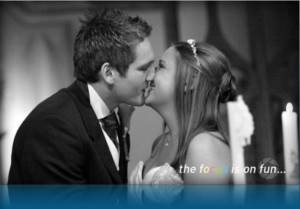
This article is intended for those who have decided to become a wedding photographer. It’s worth saying right away that a wedding photographer is a very troublesome and responsible task. But you always have to start somewhere and so we will start from the very basics.
Before you offer your services as a wedding photographer, you need to learn the basics of digital photography and your camera. You need to know your technology thoroughly and all the possibilities it provides. You need to train not on orders, but at the weddings of your friends and family. Even if they already have their own professional photographer, you still take your camera and try to benefit from this holiday. Thus, you will understand from your own experience how to photograph a wedding . Study the following few points from this lesson, which should definitely be included in your wedding photography program.



